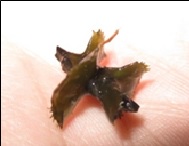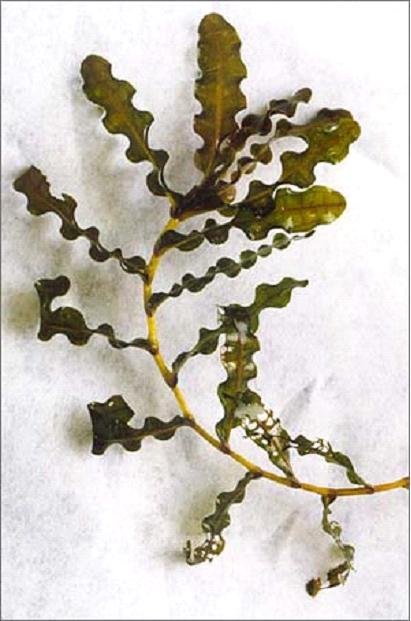Curly leaf pondweed, or Potamogeton crispus, gets its name from its rippled, wavy, and crinkled submerged leaves. The leaves are often compared to small lasagna noodles. The leaves have a rounded tip and very small teeth along the edge. Curly leaf pondweed can be an aggressive invader that can cover large portions of lakes and will grow in water up to 15′ deep. It is a non-native plant and should be removed where possible.
Curly leaf pondweed is in our lakes
In early summer of 2006, we found and pulled out one patch in Waccabuc. In 2007 and 2008 we found growing plants in a Waccabuc cove and a stand at the west end of Oscaleta. Despite pulling, it has continued to spread. Curly leaf pondweed is found at the west end of Oscaleta, throughout the channel, and in many places in Waccabuc, including the north cove. Please keep an eye out and pull all that you can!
 Young curly leaf pondweed plants start to grow in the fall and can survive under ice cover during late winter, which makes this invasive one of the first nuisance aquatic plants to emerge in the spring. Curly leaf pondweed spreads in many ways. Turions, which look like small brown pine cones, are winter buds that act like seeds and are dispersed by water movement to spread to new locations. Established plants can form large colonies from rhizomes. Curly leaf pondweed can also spread by fragmentation.
Young curly leaf pondweed plants start to grow in the fall and can survive under ice cover during late winter, which makes this invasive one of the first nuisance aquatic plants to emerge in the spring. Curly leaf pondweed spreads in many ways. Turions, which look like small brown pine cones, are winter buds that act like seeds and are dispersed by water movement to spread to new locations. Established plants can form large colonies from rhizomes. Curly leaf pondweed can also spread by fragmentation.
Impacts
Curly leaf pondweed is a highly competitive plant, capable of rapid growth and spread. Like many other invasive plants, infestations may displace native species, reduce biodiversity, impede recreational activities, and reduce property values. Unlike many plants, curly leaf tends to die back during the heat of the summer, and then regrow in the cooler waters of fall. While this means it is not in the way of boaters and swimmers, it can cause other problems. As the dense mats of vegetation decay, available oxygen in the water may be depleted. The resulting anoxic (low oxygen) conditions may lead to fish kills and can harm other aquatic organisms. Nutrients released from the decaying plant matter may also contribute to cultural eutrophication and algae blooms.
At the early stage of infestation, we might have been able to control this plant by hand harvesting. However, at this point, it is quite widespread in Oscaleta and Waccabuc. Local control is probably the only feasible option to keep it from becoming a nuisance at your waterfront. If you spot it, pull it out by the roots, carefully collect all the pieces, and dispose of the weed away from the water. Be sure to collect any turions that may come loose as you pull the plant.
This plant most likely came to our lakes as a “hitchhiker” on a boat. The plant is present in Lake Katonah and Lake Truesdale. In both of those lakes, herbicides are used in the spring as a control method and reduce the amount of plants in those lakes. Please ensure you carefully inspect all boats or water toys that come into our lakes and remove any plants or mud. See how to clean boats!
